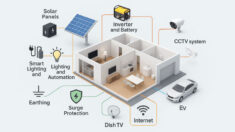
You can find electrical cables in your house. They power the lights and appliances. They are available in different cable sizes. They accommodate the amount of current required to run the machines. All cables can carry a unique amperage. It means that the load must not be more than they can carry safely.
Electrical wire sizes in mm and uses
It is challenging because the location also plays a crucial role. For example, a cable in an empty stud wall will dissipate heat more quickly than a cable in a loft. You need to consider which appliances will draw the power and their location. 1.5 mm cable easy to cope with the supply and demand of the voltage drop.
What size of cables do you need for sockets?
The following are the electrical wire sizes in mm and uses:
- A 2.5 mm twin and earth cable is enough for domestic situations. It is perfect for sockets on a ring. The size of the cable for sockets must be larger than the lighting circuits. This is because sockets need to cope with more load. Due to various appliances with different supply needs. 2.2mm writes are used for lighting circuits, socket outlets, and other general electrical installations in residential and commercial buildings.
- The most commonly available cable sizes include 1.5 and 2.5-mm twin and earth.
- There is another larger size of cable available. It has 4 mm, 6 mm, 10 mm, and 16 mm. You can use them in appliances and objects which require more electric power. Recommended for water heaters, kitchen ovens, power circuits and showers, and air conditioners. 6.0 mm are used for showers and cookers.
- Even larger cable sizes are available, ranging from 25 mm, 35 mm, 70 mm, and 95 mm, and going up to 1000 square. They are available in 20 different sizes.
The situation where you use the large cable size depends on different factors. Appliances like large cookers and electric power showers all draw a larger supply. Therefore, it needs a large size cable. Where the electric supply ends, a large-size cable is applicable. You will not have enough electric power if you use the incorrect cable size.
Basics about the size of earth wire
1.5 MM cable is one mm, and 2.5 MM is 1.5 mm for the earth wire. It is perfect for domestic sockets and lighting circuits. The cross-sectional area is applicable to domestic uses. You will see a cross-section if you slip one of the wires. This is a circle. The cross-sectional area excludes insulation.
Reasons to use different cables and flex for other things.
Different cables and flexes are applicable for other jobs. It is because they are thick and carry more current. You need thick wires for high-energy users like electric showers. You need to consider the temperature of the area or void. It is important to remember the values for the cables and flexes. They can change in domestic situations. Having multiple flexes and cables is overall quite helpful.


